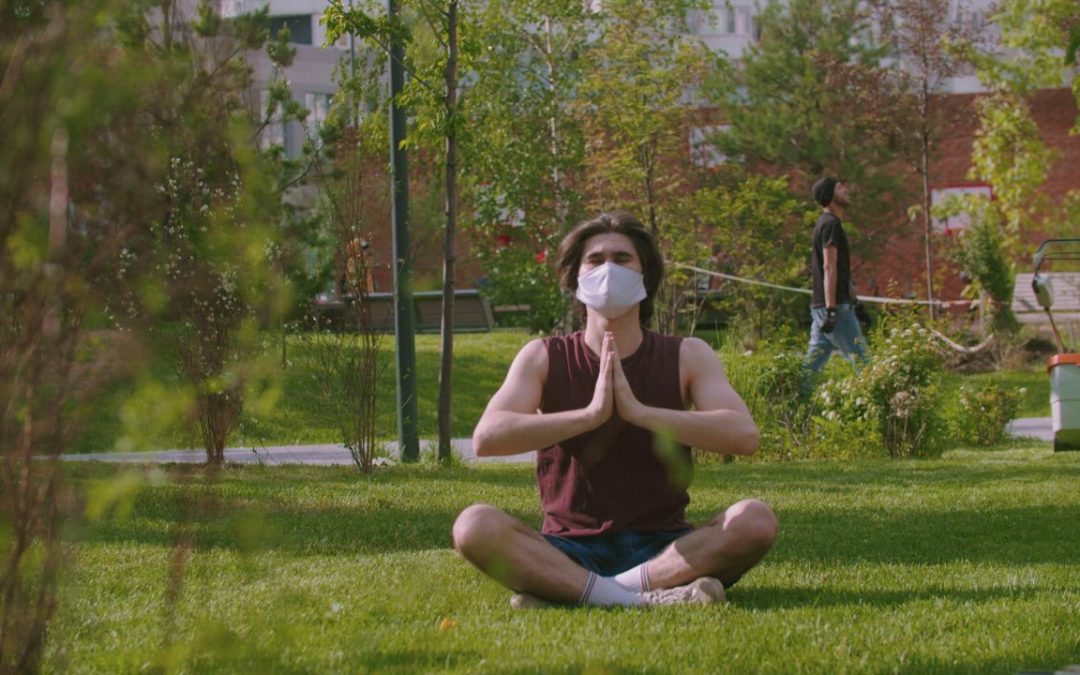By Ray Williams
October 9, 2020

“Fall down seven times, get up eight.”—Japanese Proverb
A virus pandemic. Climate change disasters. Racial and ethnic conflicts. Economic inequality. Democracy in decline. The world appears to be in disarray, and a connected fallout is our emotional and mental health. The need for coping skills and particularly resilience has never been greater.
When faced with adversity in life, how does a person cope or adapt? Why do some people seem to bounce back from tragic events or loss much more quickly than others? Why do some people seem to get “stuck” in a point in their life, without the ability to move forward?
When faced with these challenges, resilience is how well a person can adapt to the events in their life. A person with good resilience has the ability to bounce back more quickly and with less stress than someone whose resilience is less developed.
Everybody has resilience. It’s just a question of how much and how well you put it to good use in your life. Resilience doesn’t mean the person doesn’t feel the intensity of the event or problem. Instead, it just means that they’ve found a good way of dealing with it more quickly than others.
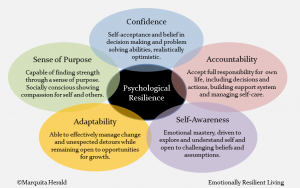
What Resilience Isn’t
Being resilient doesn’t mean that a person won’t experience difficulty or distress. People who have suffered major adversity or trauma in their lives commonly experience emotional pain and stress. In fact, the road to resilience is likely to involve considerable emotional distress.
While certain factors might make some individuals more resilient than others, resilience isn’t necessarily a personality trait that only some people possess. On the contrary, resilience involves behaviors, thoughts, and actions that anyone can learn and develop. The ability to learn resilience is one reason research has shown that resilience is ordinary, not extraordinary.
Like building a muscle, increasing your resilience takes time and intentionality. Focusing on four core components—connection, wellness, healthy thinking, and meaning—can empower you to withstand and learn from difficult and traumatic experiences. To increase your capacity for resilience to weather—and grow from—the difficulties, use these strategies.
Here are some traditional ways to build your resilience.
- Prioritize relationships. Connecting with empathetic and understanding people can remind you that you’re not alone in the midst of difficulties. Focus on finding trustworthy and compassionate individuals who validate your feelings, which will support the skill of resilience.
- Take care of your body. Self-care may be a popular buzzword, but it’s also a legitimate practice for mental health and building resilience. That’s because stress is just as much physical as it is emotional. Promoting positive lifestyle factors like proper nutrition, ample sleep, hydration, and regular exercise can strengthen your body to adapt to stress and reduce the toll of emotions like anxiety or depression.
- Avoid negative outlets.It may be tempting to mask your pain with alcohol, drugs, or other substances, but that’s like putting a bandage on a deep wound. Focus instead on giving your body resources to manage stress, rather than seeking to eliminate the feeling of stress altogether.
- Help others. Whether you volunteer with a local homeless shelter or simply support a friend in their own time of need, you can garner a sense of purpose, foster self-worth, connect with other people, and tangibly help others, all of which can empower you to grow in resilience.
- Look for opportunities for self-discovery. People often find that they have grown in some respect as a result of a struggle. For example, after a tragedy or hardship, people have reported better relationships and a greater sense of strength, even while feeling vulnerable. That can increase their sense of self-worth and heighten their appreciation for life.
- Accept change. Accept that change is a part of life. Certain goals or ideals may no longer be attainable as a result of adverse situations in your life. Accepting circumstances that cannot be changed can help you focus on circumstances that you can alter.
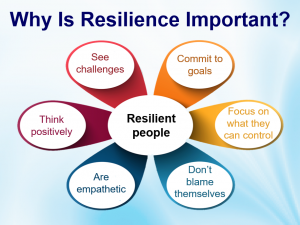
Mindfulness Builds Resilience: Research
New research shows that mindfulness builds resilience. That’s the conclusion of researchers Badri Bajaj and Neerja Pande. Writing in the journal Personality and Individual Differences, they confirm that psychological resilience is more pronounced in mindful people. The researchers also provide evidence that this highly useful quality produces many of the practice’s much-touted benefits.
The researchers concluded that resiliency is mostly cultivated from within by how we perceive and then react to stressors:“Mindful people … can better cope with difficult thoughts and emotions without becoming overwhelmed or shutting down (emotionally).Pausing and observing the mind may (help us) resist getting stuck in our story and as a result empower us to move forward.”
What is Mindfulness and What Are Its Benefits?
Mindfulness is the practice of bringing our awareness to what we are experiencing in the present, both internally and externally, without judgment. It is a wakeup call to become conscious of the ways we perceive and respond to life’s situation
Mindfulness isn’t some magical, esoteric, or new-age fad. Let’s dive deep into the scientific research behind this powerful—and continually studied—practice.
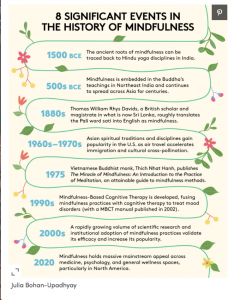
In 2020, the practice has truly gone mainstream, cropping up everywhere from boardrooms to bedrooms to our kitchen tables. Perhaps most indicative of its status in the contemporary wellness space is the sheer number of available meditation apps. More than 2,500 meditation mobile apps have launched since 2015.
An ever-growing body of clinical studies and lab research demonstrates the efficacy of mindfulness in helping to treat, manage, or reduce symptoms of a multitude of health conditions, both mental and physical. Even more exciting, scientists and experts continue to uncover new ways to wield the power of mindfulness for improving our health and quality of life. From boosting cognitive function to easing physical symptoms of stress, and building resilience, the empirical evidence speaks for itself.
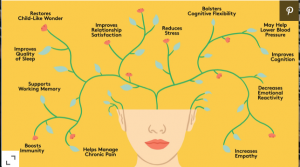
Scientific Studies Have Shown That Mindfulness Can:
- Reduce Stress. Making mindfulness meditation a habit for only a few days can reduce overall anxiety (and who couldn’t benefit from less stress?). In a 2015 study of 133 stressed, unemployed adults, published in Social Cognitive and Affective Neuroscience, a three-day intensive mindfulness meditation training intervention showed reduced activity in participants’ amygdala, the brain region that triggers the release of stress hormones.
- Improve Cognition. Reaping the benefits of mindfulness meditation takes less time than you might expect. Practicing mindfulness for just 20 minutes a day for four days significantly increased the cognitive efficiency (i.e., the ability to think clearly) on tasks that required sustained attention in 63 college students who had never practiced mindfulness previously, according to a 2010 study published inConsciousness and Cognition.
- Boost Immunity. While practicing mindfulness isn’t a surefire way to prevent sickness, it may play a role in boosting brain and immune function, according to results of a 2003 clinical trial published in Psychosomatic Medicine. Scientists performed an eight-week study measuring brain electrical activity before and after mindfulness meditation training, with both test and control groups receiving an influenza vaccine afterward. They found significant increases in antibodies among those in the meditation group, as well as higher activity in the logical left side of the brain.
- Maintain Better Working Memory. Results of a 2010 clinical trial published in the journal Emotion showed how mindfulness can increase our short-term memory capacity. Researchers examined two military groups in high-stress situations, and the group participating in an eight-week mindfulness training course (and practicing on their own after class) showed less degradation in working memory ability than the group that didn’t undergo mindfulness training.
- Help Manage Chronic Pain. A growing body of research suggests that mindfulness may make it easier to cope with chronic pain. John Kabat-Zinn, PhD, a pioneer in the field, conducted research in the 1980s on the effects of using mindfulness-based training to treat chronic pain. More recently, a 2017 study published in Annals of Behavioral Medicine showed mindfulness meditation contributed to a small decrease in chronic pain in patients. More research and larger studies are needed to confirm mindfulness meditation’s viability as a pain treatment on its own.
- Increase Empathy and Compassion. Multiple studies, including results of a 1998 clinical trial published in Journal of Behavioral Medicine and a 2015 study published in Mindfulness, have shown that mindfulness meditation practice increases overall empathy levels. In the latter study, researchers investigated the effects of psychotherapists practicing loving-kindness and compassion meditation, finding that both helped them develop more empathy toward clients and reduced the negative effects associated with empathy for pain.
- Help Lower Blood Pressure. A 2019 study published in PLOS One backed up what was previously largely anecdotal evidence that mindfulness can help to reduce hypertension (a high risk factor for heart disease) in adults. The results of a trial of 48 participants—80 percent of whom had hypertension—showed that practicing mindfulness-based stress reduction could influence the behavioral underpinnings of this disease by improving participants’ self-regulation (i.e., the ability to avoid overeating) and enhancing their self-awareness and attention control. The results were long-lasting: An assessment one year later showed participants’ blood pressure remained lower than the baseline taken at the start of the study.
- Bolster Cognitive Flexibility. Are you always multitasking? Mindfulness may help you to shift your thinking among multiple concepts with greater ease. A 2009 study in Consciousness and Cognition compared a group of Buddhists experienced in mindfulness meditation with non-meditators, finding that the first cohort performed significantly better on all measures of focused attention via timed written tests.
- Improve the Quality of Sleep. Waking up groggy after a night of tossing and turning can make it tough to function at your best. Practicing mindfulness can help you to clock better Zzzs, however, according to results of a 2015 clinical trial published in JAMA Internal Medicine. The trial tested 49 older adults (with a mean age of 66.3 years) experiencing moderate to great sleep disturbances (such as insomnia) before and after going through a structured mindfulness meditation program. Post-intervention, sleep quality was largely improved and sleep-related daytime impairment was reduced. More research is needed to determine longer-term effects of mindfulness on sleep, researchers noted.
- Decrease Emotional Reactivity. If you find yourself making decisions based on emotions, practicing mindfulness can help you disengage from emotionally upsetting situations and think more logically. A 2007 study published in Motivation and Emotion demonstrated that individuals engaging in mindfulness meditation had a weakened emotional response to unpleasant photos, allowing them to better focus on a cognitive task, and also demonstrated increased well-being.
- Improve Personal Relationships. Improving your mindfulness skills can actually boost the satisfaction you feel about your relationship. A 2007 study in Journal of Marital and Family Therapy suggests mindfulness leads to an increased capacity to handle relationship stress positively and plays a beneficial role in the health of romantic relationships.
- Restore Child-Like Wonder and Awe. Children can be enamored by an errant leaf, or bug, or flower—things we often don’t pay attention to as adults. Mindful attention may help us to see the world with fresher eyes, however. In a 2015 study published in PLOS One, practicing mindfulness meditation was shown (in some cases) to weaken sensory habituation, our tendency not to notice things around us in our everyday environments.
All of the capacities that develop and strengthen your resilience—inner calm in the midst of the storms, seeing options clearly, shifting perspectives and responding flexibly, choosing actions, persevering in the face of doubt and discouragement—are innate in your being because they are evolutionarily innate in your brain.
Research reveals that mindfulness can help us develop greater resilience – but how?
Richard Davidson, one of the world’s leading mindfulness researchers explained: “One of the ways that we think about resilience is being able to recover quickly following adversity. Being able to let go of our negative emotions once they arise, to experience them but not ruminate on them. One of the ways in which meditation seems to be helpful, is to enable us to be less sticky in our negative emotions and there are certain changes in the brain that we have found to be associated with decreased stickiness. By stickiness, we’re referring to the tendency to ruminate on or to stew in our negative emotions. When adversity happens it’s appropriate and adaptive to experience whatever negative emotions may arise, but then to let them go when they’re no longer useful. Meditation can help to facilitate that.”
It’s helpful to remember that mindfulness isn’t about stopping difficult emotions in the face of life’s challenges, but rather helping us relate more wisely to them.
Just as we can physically train before a physical challenge like a marathon, we need to mentally train in order to build up our resilience muscles that can support us through difficult times. Resilience is something we can grow through practice.
Practicing mindfulness can cultivate helpful resilience promoting factors. Learning and practicing with a mindfulness community helps build connections. Most formal practices involve the curious exploration of body sensations, thoughts, feelings, and urges, with attitudes including compassion, trust, and patience. We learn to turn toward difficulty with openness and kindness. In addition, the research indicates mindfulness is correlated with greater cognitive flexibility and self-regulation skills.
“Emotional discomfort, when accepted, rises, crests and falls in a series of waves. Each wave washes a part of us away and deposits treasures we never imagined. Out goes naiveté, in comes wisdom; out goes anger, in comes discernment; out goes despair, in comes kindness. No one would call it easy, but the rhythm of emotional pain that we learn to tolerate is natural, constructive and expansive.” – Martha Beck
Researchers have discovered that some people are biologically more vulnerable to stress. How our brains and bodies respond to adversity can vary significantly. Fortunately, we can train ourselves to cope more effectively. In fact, some Aboriginal educators believe that resilience is an inborn quality that just needs to be awakened. Mindfulness practices can awaken resilience by helping us learn to regulate our central nervous systems so that higher reasoning is available for better decision making. The practices also help us become more aware of when we are in need of self-care so that we can minister to ourselves appropriately and respond more effectively to life’s challenges.
Fortunately, resilience is not only learnable, it’s contagious. Research shows us resilient communities contain more resilient individuals and resilient parents tend to raise resilient children. This is the real reason why your own mindfulness practice is so important. You are not the only beneficiary of your efforts – as you engage mindfully with the world around you, your personal practice becomes a benefactor contributing to the greater good.
Our Emotions and Resilience
What you can do instead is learn to manage surges of negative emotions and intentionally cultivate positive ones, such as kindness, gratitude, generosity, delight, and awe. Positive emotions shift the brain out of the contraction and reactivity of the negativity bias, into the receptivity and openness that increase your response flexibility. The direct measurable outcome of these practices is resilience.
Focusing on positive emotions is not meant to bypass or suppress dark, difficult, afflictive ones. Your experiences of angst, pain, and despair are very real. But you can learn to acknowledge, hold, and process those emotions. You broaden your habitual modes of thinking or acting and build enduring, resilient resources for coping. These include increasing social bonds and social support and deepening insights that help place events in a broader context. You find a way through, and come out the other side.
All emotions—the ones you dislike and dread as well as the ones you welcome and enjoy—can guide your behaviors in resilient self-protecting or self- enhancing ways. You don’t have to be afraid of your emotions, be stuck in them, or be swept away by them. You do have to take responsibility for how you experience and express them.
Here are Some Mindfulness Practices:
Practice: Taking in the Good. —Adapted from Rick Hanson, Hardwiring Happiness. Pause for a moment and notice any experience of kindness, gratitude, or awe that you have experienced today or remember from the past. Maybe your neighbor drove you to and from work for three days while your car was in the shop, or you saw a blue heron rise up from a pond at dusk. Attune to the felt sense of the goodness of this moment—a warmth in your body, a lightness in your heart, a little recognition of “Wow, this is terrific!” Focus your awareness on this felt sense of goodness for 10–30 seconds. Savor it slowly, allowing your brain the time it needs to really register the experience and store it in long-term memory. Set the intention to evoke this memory five more times today. This repeats the neural firing in your brain, recording the memory so you can recollect it later, making it a resource for your own sense of emotional well-being, and thus strengthening the inner secure base of resilience. As you experience and re-experience the moment, register that not only are you doing this, you are learning how to do this. You are becoming competent at creating new neural circuitry for resilience.
Practice: Tune in to Act Wisely. The practices of attending and attuning will begin creating the space to help you respond to emotions in a new and more resilient way. Regular practice will make it easier to shift from negativity to positivity. Apply the principle of little and often. Practice again and again until these skills become the new habits of perceiving and responding to your emotional landscape. Then you can choose your response.
Practice: Attending. This practice can deepen your capacity to become present to and consciously aware of your experience without needing to leave or push it away to maintain your emotional equilibrium. Sit quietly in a place where you won’t be interrupted for at least five minutes. Come into a sense of presence, knowing you are here, in your body, in your mind, in this moment, in this place. Whatever body sensation, feeling, or thought comes up, simply notice it, acknowledge that it has shown up on your radar, allow it to be there, and accept that it is there. At this point you’re not wondering about it or trying to figure it out, just attending to it enough to register the experience in your awareness. At this stage in the exercise, you have come to a choice point. You can let go of attending to the experience of the moment and refocus your attention on the quiet, spacious awareness, or you can attune to the felt sense of the experience to decipher its message.
Practice: Attuning. This practice entails discerning the particular flavor of an emotion. It helps you learn to label complex, subtly nuanced emotions, such as those of feeling lonely or suspicious, which builds your emotional literacy.See if you can identify any feeling or sensation in the experience you were attending to in your body. Begin to label it—shaky, tight, churning, bubbling, contracting, expanding. Try not to create a story about it. Just feel it and name it. Sometimes it’s a challenge to put your finger on the exact nuance or flavor of the message. So just try to find a good enough label for now: “This is contentment,” “This is aggravation,” or “This is despair.” Whatever feeling you are attuning to, and however you choose to label it, this feeling is what it is. All you have to know at this point is that you can know what it is and label it in a way that is useful to you. You can trust in your ability to know and label a feeling even if you change your mind later about what it is. Once you can name an emotion, you are on the way to making sense of it and taking wise action toward dealing with it.
Everyday Routines That Are Perfect for Practicing Mindfulness
Time to turn off auto-pilot and be more present. How? Give these five daily moments the mindfulness treatment.
More often than not, we end up running through our days on autopilot, juggling multiple tasks without even a second thought, letting our minds be anywhere but present. When we do this, we’re likely neglecting all of our senses—touch, smell, sight, hearing, taste, and spirit—which are crucial to absorbing each moment, explains Raghu Kiran Appasani, MD, a psychiatrist, neuroscientist, and the founder and CEO of The Minds Foundation.
Brushing Your Teeth
Typically, when going through the motions of cleaning our pearly whites, we’re doing anything but concentrating on the actual act of brushing. But this (often tedious) daily routine is an opportune moment to sneak in some mental time. Use mindful awareness to notice every small step involved in this grooming ritual, from how you reach for the toothbrush to the sensations of each movement of your hand, says Elizabeth Ohito, LCSW, a psychotherapist in California. Immerse yourself in your senses—notice what your toothpaste tastes like, how it feels on your teeth and tongue (minty, tingly, foaming?), and the sound the bristles make as you brush.
Going for a Walk
Take your cue from Buddhist monk Thich Nhat Hanh, often referred to as the father of mindfulness. Hanh, who has written books on mindful walking, has been reported as saying he teaches walking slowly and deliberately with each step. This method emphasizes that it’s helpful to bring awareness to the soles of your feet and the pressure points where your feet make contact with the ground. She suggests noticing: “Do your feet make a sound against the surface they’re on? Do they have a certain temperature? What other sensations are there?” Also noteworthy: Research shows that moving (specifically walking) and mindfulness together help alleviate stress and anxiety.
Making and Drinking Your Morning Cup of Coffee or Tea
We have to get out of the habit of multitasking. One good way to practice is while enjoying your morning coffee (or tea, or whatever you like sip on). When you sit down for your morning coffee, just drink the coffee—don’t read, listen to music, or look at your digital device “Just sit. Know that you are sitting and know that you are drinking coffee and be curious about the activity. Turn mindfulness toward the sensory experiences of making coffee. she says. Notice the texture of the bean and the cup, the smell of the coffee grounds, the temperature of the coffee, your eagerness to drink it. Coffee or tea routines are a great opportunity to notice physical and emotional sensations. Without analysis or self-judgment, what do you notice? Where are your thoughts and emotions while you sit with your cup? What do you taste, feel, and smell? These conscious observations will ground you in the present and help you start each day with intention.
Eating a Meal
In a similar vein, mealtimes are another ideal part of the day to practice mindfulness. Ohito says mindfulness allows us to slow down long enough to help savor the experience of eating (think: taste, smells, and sounds). It’s also a great time to reflect on all of the people and processes that brought this meal to your table—from the farm workers to the truck drivers to the person who stocked the ingredients you used to prepare what you’re eating at the grocery store. Take a mindful minute of reflection and gratitude to appreciate their contributions to the meal you’re eating.
What’s more, eating with awareness of yourself and the food in front of you—in other words, being mindful of what and how you eat—can lead to overall healthy eating habits that last, says Linda Nikolakopoulos, MS, RD, LDN, a registered dietitian and licensed nutritionist in Massachusetts. She notes that this practice is about listening to your body. “Mindful eating helps us recognize if we’re eating due to hunger, emotions, stress, or boredom,” she says. “It also points out if we’re mindlessly snacking while doing other things such as working, cleaning, or watching TV, which can help us recognize when we’ve eaten enough instead of realizing it after we’ve already gone overboard.” Research backs up the theory, suggesting that mindfulness can indeed help thwart unhealthy eating as a coping method.
Taking a Shower
Mindfulness in the shower? Absolutely. Shower or bath time is kind of the perfect place to rinse away distractions as thoughts bubble to the surface. Give yourself enough time [to shower] so you are not rushed. Try to be fully present and immersed in the experience of washing my body. Take note of everything while washing: the sensation of water hitting her skin, the temperature, and the smell of the body wash and shampoo. Gratitude is a nice byproduct of this. Be grateful for the fresh clean water.
Mindfulness Breathing Exercises You Can Do Anywhere, Anytime
We breathe all day, every day without thinking about it—but something truly transformative can happen when the breath becomes something we do think about.
Attention to the breath—and intention of the breath—is a fundamental facet of mindfulness, the practice of cultivating non-judgmental awareness of the present moment. Mindful breathing techniques can be used to moor you to the present, to influence your thoughts and emotions, and to promote calm (mentally and physiologically). Different types of breathing techniques have been linked to numerous health benefits, from reducing oxidative stress levels (free radical imbalance) and regulating negative emotions, to easing anxiety symptoms and improving cardiovascular function.
The breath is such a great anchor [to the present] because it’s with you and happening naturally all the time. If you get in the habit of using your breath as an anchor, and become more aware of your thoughts and emotions, you can stop them before they gain momentum in a way that contributes to stress or anxiety.
Breathing exercises are an accessible entry point into mindfulness. You already know how to inhale and exhale. Now, learn how to observe your breath, to sense it, return to it, and eventually gain better control over it to unlock its remarkable power. Start with these five mindfulness breathing techniques.
Mindful Breathing
“A very common foundational practice [that] every mindfulness training program has is mindfulness of breathing: taking an observational stance to the ongoing occurrence of your breath,” says Amishi Jha, PhD, a neuroscientist and associate professor in the department of psychology and the director of contemplative neuroscience for the UMindfulness initiative at the University of Miami.
This type of exercise doesn’t involve breath manipulation—it’s just about placing awareness on its natural occurrence. Sounds simple, but it’s not always easy to do. Begin by breathing normally and becoming a focused observer of your breath. It’s helpful to hone in on a physical cue, like the rise and fall of your belly or the sensation of air in your nostrils (cool air coming in, warmer air going out). When your mind naturally wanders (and it will—that’s inevitable), make a note of it, then simply return to the occurrence of each inhale and exhale.
Breathing in this way, even for a minute or two, helps eliminate distraction, release negative thoughts, improve self awareness, and quiet a racing mind. The more you do it, the easier it will get—and the more you’ll start to notice the benefits in your daily life.
Counting Breaths
Here’s a similar mindful breathing technique that incorporates another mental cue to help you concentrate: counting each breath. You’ll notice that it’s surprisingly hard to follow your breath—one good trick for staying on task is to count it. “For people who have really busy minds, adding the component of counting is very helpful,” Jha says. “Techniques like counting help take us out of thought loops that feed stress, anxiety, or negative emotions.”
Deep Breathing
Here, you can start to practice changing your breath—deepening it—for a desired outcome. Deep breathing, also called belly breathing or diaphragmatic breathing, is exactly what it sounds like and can help reduce stress and promote a sense of calm. Breathing very fully into the belly, then exhaling completely, works to deactivate the stress response and activate the “rest and digest” state.Stressed? Overwhelmed? Panicked? Spend a few intentional minutes taking calm, deep (but gentle) breaths, which will signal to your brain that everything is OK.
2-4 Breathing
This type of breath work involves extending the exhale so it’s longer than the inhale. Emphasizing the exhale is meant to stimulate the parasympathetic nervous system (PNS), the calming counterpart to our stress-induced sympathetic nervous system (SNS). While the SNS accelerates heartbeat, breathing, and blood flow, the PNS slows breathing, heart rate, blood pressure, and metabolism. When your stress response is in overdrive (and whose isn’t?), promote serious relaxation with a 2-4 breathing exercise: inhale for two counts and immediately exhale for four counts. This type of meditative breathing is taught to Navy Seals.
Energizing Breaths
You can harness the breath to perk yourself up, too. When you’re feeling sluggish, invigorate your mind and boost energy and alertness with this breathing technique, based on a Kundalini yoga technique called segmented breathing. Inhale in four equal, but distinct segments to fill the lungs, then exhale in one, long, smooth segment to empty the lungs completely (repeat three or four times).
Making Mindfulness A Way of Life
Charles Francis, author of numerous pieces on mindfulness, says, “We can’t achieve true happiness until we understand our suffering and learn how to overcome it. As long as our happiness depends on things that are impermanent, we will always be disappointed. Furthermore, as long as our practice remains only a part of our lives, our spiritual growth and freedom from suffering will be limited. If we want to achieve long-lasting peace and serenity, then our spiritual practice must become a way of life, and our happiness must depend on something that is constant. One thing in our lives that is constant is the present moment, and this is at the core of mindful living.”
Summary:
As we face the challenges and stresses caused by traumatic events in our lives, science tells us embracing and practicing mindfulness can build resilience and help you weather the storms.
Copyright: Neither this article or a portion thereof may be reproduced in any print or media format without the express permission of the author.
Read my latest book:I Know Myself And Neither Do You: Why Charisma, Confidence and Pedigree Won’t Take You Where You Want To Go, available in paperback and ebook formats on Amazon and Barnes and Noble world-wide.


